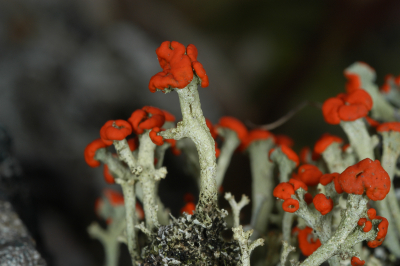Discovering the Hidden World of Lichens in the Great Smoky Mountains
There’s something magical about walking through the misty valleys of the Great Smoky Mountains National Park. As the fog lifts and sunlight filters through the ancient trees, a hidden world reveals itself—one that I’ve been fortunate to explore and write about for years. While most visitors come for the majestic views, towering trees, and glimpses of wildlife, there’s an overlooked treasure decorating almost every surface: lichens.
These fascinating organisms represent one of the most surprising biodiversity stories in the Smokies, and until recently, we barely knew they existed here in such abundance.
The Lichen Revolution in the Smokies
Just two decades ago, lichens were largely undocumented in Great Smoky Mountains National Park. It’s hard to believe now, as I run my fingers over the colorful crusts and leafy growths that adorn rocks and trees throughout the park. These organisms—not quite plants, not quite fungi, but a remarkable partnership between fungi and algae or cyanobacteria—have been here all along, silently contributing to the ecosystem.
When I first started writing about the Smokies, lichen diversity wasn’t on my radar. Now, it’s one of the most fascinating chapters in the park’s ongoing natural history story.
What Makes Lichens Special?
Lichens are nature’s perfect example of cooperation. They form when fungi provide structure and protection for algae or cyanobacteria, which in turn produce food through photosynthesis. This relationship creates an entirely new organism that can survive in environments where neither partner could thrive alone.
In the Smokies, lichens come in an astonishing variety of forms:
- Crusty (crustose) lichens that cling tightly to rocks and tree bark
- Leafy (foliose) varieties that form flat, lobed structures
- Shrubby (fruticose) types that branch upward like tiny trees
- Gelatinous lichens that become rubbery when wet
Each type plays a unique role in the park’s ecology, from breaking down rock into soil to providing food and shelter for countless small creatures.
The Great Lichen Discovery
I remember the excitement in the scientific community when researchers began cataloging the park’s lichen diversity as part of the All Taxa Biodiversity Inventory (ATBI). What they found was nothing short of remarkable: hundreds of species previously undocumented in the park, including dozens new to science entirely!
Today, scientists believe the Smokies may be home to over 1,000 lichen species—an extraordinary concentration that makes this one of the lichen diversity hotspots of North America.
| Time Period | Known Lichen Species in the Smokies |
|---|---|
| Before 2000 | Fewer than 200 |
| Current Estimate | Over 1,000 |
Why Lichens Matter in the Smokies
On my many hikes through the park, I’ve come to appreciate lichens as more than just colorful decorations. These organisms are environmental superheroes:
- They’re among the first pioneers to colonize bare rock, helping create soil
- They serve as sensitive indicators of air quality (a critical concern in the Smokies, which has historically suffered from air pollution)
- They provide food for wildlife, from snails to deer
- Some species fix nitrogen from the air, enriching the soil
- They contribute to the park’s staggering biodiversity
What fascinates me most is how lichens connect to the human history of the Smokies. Cherokee people used certain lichens for dyes and medicines, knowledge that sustained communities in these mountains for generations.
How to Spot Lichens on Your Next Visit
The next time you visit the Great Smoky Mountains National Park, take a moment to look closely at the rocks, trees, and soil around you. Those patches of color—green, gray, orange, or yellow—are likely lichens. Bring a magnifying glass if you can; these organisms reveal incredible detail up close.
Some of my favorite lichen-spotting locations include:
- The Alum Cave Trail, where rock faces display vibrant lichen communities
- Old-growth forest areas, where ancient trees host diverse lichen species
- Exposed rocky areas along the Appalachian Trail
Remember that lichens grow extremely slowly—some may be hundreds of years old—so please observe without touching or collecting.
Protecting the Lichen Legacy
As someone who has written about the Smokies for years, I’ve witnessed how increased knowledge leads to better conservation. The discovery of the park’s rich lichen diversity has highlighted new conservation priorities, especially related to air quality and climate change.
These sensitive organisms can tell us so much about the health of our beloved mountains. When we protect the conditions that allow lichens to thrive, we’re protecting the entire ecosystem that makes the Smokies special.
The Ongoing Discovery
The story of lichens in the Great Smoky Mountains is still being written. Researchers continue to find new species and understand more about how these organisms function in the ecosystem. It’s a humbling reminder that even in one of America’s most visited and studied national parks, there are still discoveries waiting to be made.
I find that deeply inspiring. The mountains I’ve grown to love over years of writing about them still hold secrets—if we just look closely enough.
Experience the Wonder Yourself
Next time you visit the Smokies, I encourage you to take a moment to appreciate these overlooked wonders. Slow down, look closely at a tree trunk or boulder, and you’ll begin to see an intricate world that has been there all along, waiting to be discovered.
In the meantime, the park offers information about lichens through ranger programs and visitor center displays. It’s worth learning more about these fascinating organisms that represent one of the greatest biodiversity success stories in Great Smoky Mountains National Park.

